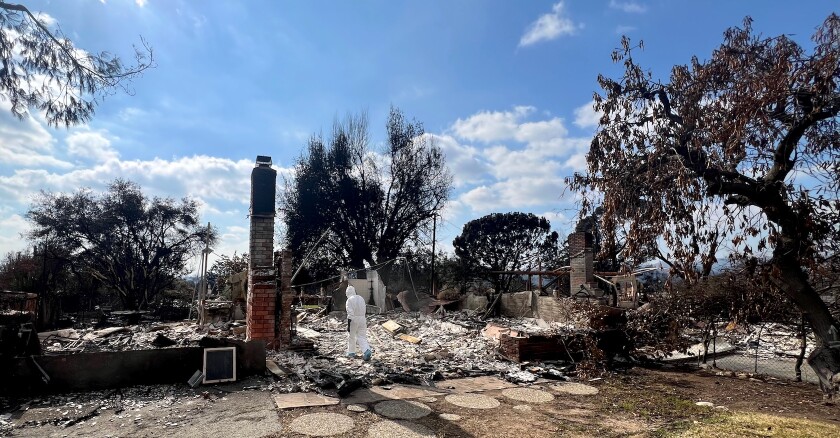The woman didn’t appear to be homeless, but her eyes showed she feared it. As my daughter and I continued homeward, she remarked that too many people were in the same situation, just one event away from the streets. The next day, such an event came to us.
On the morning of Jan. 7, I logged on to work as a Governing senior staff writer in my home office, watching the worst Santa Ana winds I could remember strip leaves off the avocado tree outside my window and the bougainvillea beyond it.
At 10:30 a.m., a fire broke out in the mountains above the Pacific Palisades. Fueled by wind gusts of more than 80 miles per hour, it spread at deadly speed. Unbelievably, the fire flew down the hills all the way to the ocean. Lifeguard towers were burning. It was heartbreaking and astounding, even worse than what the local weatherman had warned might happen. I prayed that nothing would break out in the mountains near us. We’d had several fires nearby during 23 years in our home, but never such wind.
At 6:18 p.m., news came that a fire had started in Eaton Canyon, just a few miles from us. In a strange way, this was an emotional relief. I could shut off unproductive worry about possible dangers and go into action against real ones.
After what we’d seen in Palisades, it was hard to imagine we wouldn’t need to evacuate. My daughter, who had been living with us, wasn’t willing to wait. She left for her boyfriend’s place in Monterey Park, a safe distance from the fire.

We didn’t think we’d be leaving everything else behind forever.
We inched our way away from our home, somehow finding a route with minimal hazard. My wife looked back and saw a monstrous snake of fire coming down the mountains toward us, pushed by wind gusts that may have reached 100 mph. A lifelong Californian, she’d seen many wildfires, but nothing so feral and terrifying.
We made it to our daughters in Monterey Park by 10 p.m. Everyone was crying, bereft. Our girls were already certain our house was gone. They were sorry they couldn’t do more to help us. My wife and I weren’t willing to give up hope yet. No one slept that first night. Everything was so sudden, incomprehensible. We searched compulsively for information about the path of the fire from news, social media, friends. A local started posting icons on a map of Altadena to show where homes had been lost, based on reports sent to him. It looked like our block had been spared.
In the end, we weren’t so lucky. The next day, we received a photo of our home from a friend: nothing but a pile of rubble around a chimney. The unthinkable was reality.
Where do you find your bearings in such a storm? Often, in the acts of friends and generous strangers. My younger daughter’s best friend, a Londoner she met at UCLA, started a GoFundMe campaign that drew a surprisingly vigorous response. My editors at Governing assured me they have my back and I have my job. Just get whole. I would wish the same for every displaced person, but fear many will lose jobs and income at their greatest hour of need.

Like a person who’s lost a limb, I can’t quite get it through my head that my home isn’t still there. We installed a linoleum floor in our small kitchen recently, with all the hues of the San Gabriel Mountains. It still seems real. I can feel myself standing on it, relishing its color and texture. I am in the kitchen making coffee, looking out at the native plant garden I nurtured for two decades and watching birds in the yard. Driving up Route 2 toward the San Gabriels, I have the comforting sensation that I’m almost home. But the reverie breaks when I realize there’s nothing at the end of the road.

The concept of “essential items” has nuance that’s painful in hindsight. It’s easy to see why you’d want to keep a birth certificate or wedding photo close at hand (though we failed with the latter). But where do you draw the line? I worked as a theatre composer in years past. It never occurred to me to scan my best work and save it in the cloud or just put it in a folder I could grab. Every note I ever put on paper burned.
As news of our loss has spread, I’ve heard from people who haven’t reached out to me in years, some in decades. I wouldn’t have assumed I was still present in their lives. I’m receiving deep-felt expressions of love and appreciation of the sort usually reserved for funeral ceremonies. I’m grateful they are coming before I cross over.
We have shelter. For the time being it’s not costing us anything, another godsend. We have insurance to cover rental housing while we rebuild, but we’ll likely need to make it stretch three years or more, and we still have a mortgage to pay. Where will we live? Los Angeles County has an outsized homeless population because housing is scarce and unusually expensive. How much worse will this be when you factor in thousands of lost homes and displaced persons? We’re working with people who know and care about us to find a place, holding faith in forces that have brought so many beautiful things to our lives. (Or reminding ourselves to do so.)
I was finishing a story about homelessness on the day the fires started. I’m not yet as anxious as the woman my daughter and I met on our walk. But closer than I ever expected to be.










